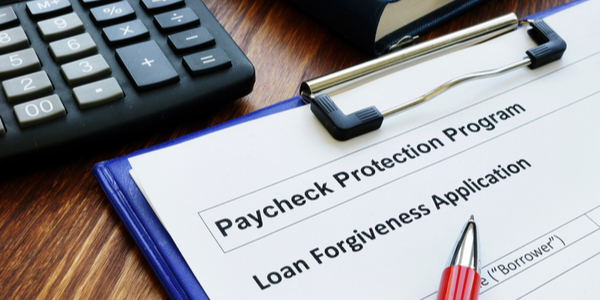New Guidance on Loan Forgiveness and SBA Loan Review Procedures

On June 22, the SBA issued the Loan Forgiveness Interim Final Rule (LF-IFR) and Loan Review Procedures Interim Final Rule (LR-IFR). These IFRs give new guidance to the PPP loan forgiveness provisions of the CARES Act and insight to the Loan Review Procedures for businesses. Much of the LF-IFR reiterates the changes made under the Paycheck Protection Program Flexibility Act (PPPFA) reported in previous letters, but the LF-IFR did include some additional guidance. The LR-IFR provided guidance on the SBA loan forgiveness review process.
The following summarizes the new guidance included in the two new IFRs:
- A borrower can apply for loan forgiveness before the end of the covered period at any time after they have used the full amount of the loan proceeds for which it is requesting forgiveness.
- If a borrower applies for loan forgiveness before the end of the covered period and the employer has reduced any employee wages by more than 25%, the borrower must account for the wage reduction for the full covered period (up to 24 weeks). The example in the IRF shows how the calculation would work.
- Example: A borrower is using a 24-week covered period. This borrower reduced a full-time employee’s weekly salary from $1,000 per week during the reference period to $700 per week during the covered period. The employee continued to work on a full-time basis during the covered period, with an FTE of 1.0. In this case, the first $250 (25% of $1,000) is exempted from the loan forgiveness reduction. The borrower seeking forgiveness would list $1,200 as the salary/hourly wage reduction for that employee (the extra $50 weekly reduction multiplied by 24 weeks). If the borrower applies for forgiveness before the end of the covered period, it must account for the salary reduction for the full 24-week covered period (totaling $1,200).
- A borrower must apply for loan forgiveness within 10 months of the end of the covered period. This is an extension from the original 6 months. If no application is made by this time, the borrower must begin making payments of principal and interest on the full loan amount. Loan payments are deferred until either a loan forgiveness is approved by the SBA or as stated here 10 months after the end of the covered period whichever is earlier.
- If the SBA determines, as a result of an audit, that the loan is not eligible for forgiveness, the borrower must begin making principal and interest payments on the loan. The loan payments will be made in accordance with the loan terms with a maturity date of either 2 years or 5 years depending on the original loan origination date and/or agreed upon extensions.
- The lender will have 60 days to review the loan forgiveness application (LFA) and issue a decision to the SBA. Within 90 days the SBA will respond to the lender, absent a SBA review of the loan.
- Allows a borrower, in some circumstances, to request that the lender reconsider a denied LFA or ask the SBA to review the decision.
- LR-IFR also includes details regarding what to include in the LFA and what the lender is required to review. The SBA has indicated that it will provide guidance on the audit review process in the future.
You can find the Loan Forgiveness Interim Final Rule (LF-IFR) and Loan Review Procedures Interim Final Rule (LR-IFR) on the SBA’s website.
Guidance on loan forgiveness calculations for owner compensation previously reported but worth mentioning again in this post:
- Employer health insurance contributions for S corporation owners cannot be included when calculating payroll costs; however, employer retirement contributions for S corporation owners are eligible costs.
- For owner-employees and self-employed individuals, including those who file Schedule C, Profit or Loss From Business, or Schedule F, Profit or Loss From Farming, forgiveness for owner compensation is calculated for the eight-week period as 8 ÷ 52 × 2019 compensation, up to a maximum of $15,385, in total for all businesses. For the 24-week period, the forgiveness calculation is limited to 2.5 months’ worth (2.5 ÷ 12) of 2019 compensation, up to $20,833, also in total for all businesses.
- C-corporation owner-employees are capped by the amount of their 2019 employee cash compensation and employer retirement and health insurance contributions made on their behalf.
- S-corporation owner-employees are capped by the amount of their 2019 employee cash compensation and employer retirement contributions made on their behalf, but employer health insurance contributions made on their behalf cannot be separately added because those payments are already included in their employee cash compensation.
- Schedule C or F filers are capped by the amount of their owner compensation replacement, calculated based on 2019 net profit.
- General partners are capped by the amount of their 2019 net earnings from self-employment (reduced by claimed section 179 expense deduction, unreimbursed partnership expenses, and depletion from oil and gas properties) multiplied by 0.9235.
- For self-employed individuals, including Schedule C or F filers and general partners, retirement and health insurance contributions are included in their net self-employment income and therefore cannot be separately added to their payroll calculation.
We will continue to keep you updated. Should you have any questions, please don’t hesitate to reach out to your tonneson + co representative.
Let's Talk
If you’re interested in working with Tonneson + Co, please reach out to us. We look forward to hearing from you!
